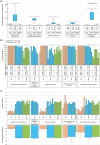Guideline for the analysis of the microbial communities of the human upper airways
- PMID: 35923899
- PMCID: PMC9341376
- DOI: 10.1080/20002297.2022.2103282
Guideline for the analysis of the microbial communities of the human upper airways
Abstract
The recent COVID-19 pandemic prompted a rapid-growing interest in the investigation of the human microbiota of the upper airways. In fact, the resident microbial community of this body district may have an influence on the onset of SARS-CoV-2 infection and its clinical course in terms of presence, symptom severity, and outcomes. However, several microbiological methodologies are available to study the human microbiota, reflecting the extensive fragmentation of methodological approaches. We investigate the impact of two critical steps that can induce biases in the downstream analyses, i.e. sampling method and microbial DNA extraction kit employed. We observed major discrepancies regarding the total amount of prokaryotic DNA that could be retrieved from a biological sample and the proportion between bacterial DNA and human host DNA. Moreover, shotgun DNA sequencing and taxonomic profile reconstruction also revealed correlations between sampling methods and the procedures applied for microbial DNA extraction. Based on all the data collected in this study, we formulate indications regarding the most efficient and reliable methodological procedures for the metagenomic analyses of the upper airways' microbiota to maximize accuracy and reproducibility.
Keywords: Metagenomics; microbiome; microbiota; shallow shotgun.
© 2022 The Author(s). Published by Informa UK Limited, trading as Taylor & Francis Group.
Conflict of interest statement
No potential conflict of interest was reported by the author(s).
Figures


Similar articles
-
Evaluation of Host Depletion and Extraction Methods for Shotgun Metagenomic Analysis of Bovine Vaginal Samples.Microbiol Spectr. 2022 Apr 27;10(2):e0041221. doi: 10.1128/spectrum.00412-21. Epub 2022 Apr 11. Microbiol Spectr. 2022. PMID: 35404108 Free PMC article.
-
Host DNA depletion efficiency of microbiome DNA enrichment methods in infected tissue samples.J Microbiol Methods. 2020 Mar;170:105856. doi: 10.1016/j.mimet.2020.105856. Epub 2020 Jan 30. J Microbiol Methods. 2020. PMID: 32007505
-
Analysis of the intestinal microbiota using SOLiD 16S rRNA gene sequencing and SOLiD shotgun sequencing.BMC Genomics. 2013;14 Suppl 5(Suppl 5):S16. doi: 10.1186/1471-2164-14-S5-S16. Epub 2013 Oct 16. BMC Genomics. 2013. PMID: 24564472 Free PMC article.
-
Practical considerations for sampling and data analysis in contemporary metagenomics-based environmental studies.J Microbiol Methods. 2018 Nov;154:14-18. doi: 10.1016/j.mimet.2018.09.020. Epub 2018 Oct 1. J Microbiol Methods. 2018. PMID: 30287354 Review.
-
The future of skin metagenomics.Res Microbiol. 2014 Feb-Mar;165(2):69-76. doi: 10.1016/j.resmic.2013.12.002. Epub 2013 Dec 20. Res Microbiol. 2014. PMID: 24361423 Review.
Cited by
-
Benchmarking DNA isolation methods for marine metagenomics.Sci Rep. 2023 Dec 13;13(1):22138. doi: 10.1038/s41598-023-48804-z. Sci Rep. 2023. PMID: 38092853 Free PMC article.
-
Microbial-enrichment method enables high-throughput metagenomic characterization from host-rich samples.Nat Methods. 2023 Nov;20(11):1672-1682. doi: 10.1038/s41592-023-02025-4. Epub 2023 Oct 12. Nat Methods. 2023. PMID: 37828152 Free PMC article.
-
Standardizing the approach to clinical-based human microbiome research: from clinical information collection to microbiome profiling and human resource utilization.Osong Public Health Res Perspect. 2025 Jun;16(3):300-307. doi: 10.24171/j.phrp.2024.0319. Epub 2025 Apr 11. Osong Public Health Res Perspect. 2025. PMID: 40211685 Free PMC article.
References
-
- Gollwitzer ES, Saglani S, Trompette A, et al. Lung microbiota promotes tolerance to allergens in neonates via PD-L1. Nat Med. 2014;20(6):642–647. - PubMed
LinkOut - more resources
Full Text Sources
Molecular Biology Databases
Miscellaneous
